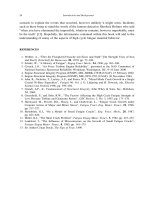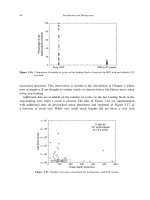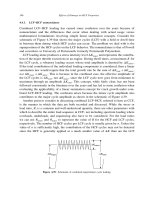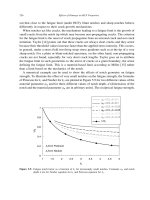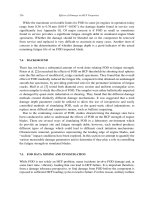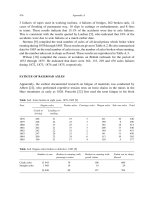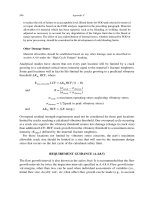Concise Dictionary of Materials Science Part 5 potx
Bạn đang xem bản rút gọn của tài liệu. Xem và tải ngay bản đầy đủ của tài liệu tại đây (40.5 KB, 4 trang )
where H and S are the enthalpy and the entropy, respectively, and T is the
absolute temperature. The enthalpy
H = U – PV
where U is the internal energy, P is the pressure, and V is the volume.
Gibbs’ free energy is also known as free enthalpy.
Gibbs’ phase rule/law
Interrelation between the number of components, C, the
number of phases, P, and the number of degrees of freedom, F, in some
equilibrium thermodynamic system:
F = C – P + 2
in the case of varying temperature and pressure. If the pressure is constant,
F = C – P + 1
In a binary system (i.e., at C = 2) at a constant pressure, the independent
variables can be the temperature and the concentration of one of the
components. If P = 1, then F = 2, which means that, in a single-phase field
of the corresponding phase diagram, both the temperature and the com
-
position of the phase can be changed independently as long as the system
remains single-phased. If P = 2, then F = 1, which means that, in a two-
phase field, only one variable can be changed independently. In the case
of the arbitrarily chosen temperature, the compositions of the phases are
fixed, and in the case of the arbitrarily chosen composition of one of the
phases at a given temperature, the composition of the other phase is fixed.
Finally, if P = 3, then F = 0, i.e., in a three-phase field (in binary systems,
it is represented by a horizontal line contacting three single-phase fields),
the compositions of all the phases concerned are fixed and the phase
equilibrium can take place at a constant temperature only. This is the reason
why all the three-phase reactions in binary systems are termed invariant.
In ternary systems (C = 3), invariants are reactions with four participating
phases; whereas in a reaction with three participating phases, the compo
-
sitions vary in the course of the reaction, and the reaction develops in a
temperature range. See, e.g., eutectic and peritectic reactions.
Gibbs–Thomson equation
Description of an alteration in chemical potential,
µ, induced by a curved interface (free surface, phase boundary, or grain
boundary):
∆µ = 2σ/ρ
where σ and ρ are the interfacial energy and the radius of interface
curvature, respectively. Chemical potential reduces when the interface
migrates toward its center of curvature. The same effect reveals itself in
the dependence of the solubility limit on the interface curvature:
© 2003 by CRC Press LLC
where H and S are the enthalpy and the entropy, respectively, and T is the
absolute temperature. The enthalpy
H = U – PV
where U is the internal energy, P is the pressure, and V is the volume.
Gibbs’ free energy is also known as free enthalpy.
Gibbs’ phase rule/law
Interrelation between the number of components, C, the
number of phases, P, and the number of degrees of freedom, F, in some
equilibrium thermodynamic system:
F = C – P + 2
in the case of varying temperature and pressure. If the pressure is constant,
F = C – P + 1
In a binary system (i.e., at C = 2) at a constant pressure, the independent
variables can be the temperature and the concentration of one of the
components. If P = 1, then F = 2, which means that, in a single-phase field
of the corresponding phase diagram, both the temperature and the com
-
position of the phase can be changed independently as long as the system
remains single-phased. If P = 2, then F = 1, which means that, in a two-
phase field, only one variable can be changed independently. In the case
of the arbitrarily chosen temperature, the compositions of the phases are
fixed, and in the case of the arbitrarily chosen composition of one of the
phases at a given temperature, the composition of the other phase is fixed.
Finally, if P = 3, then F = 0, i.e., in a three-phase field (in binary systems,
it is represented by a horizontal line contacting three single-phase fields),
the compositions of all the phases concerned are fixed and the phase
equilibrium can take place at a constant temperature only. This is the reason
why all the three-phase reactions in binary systems are termed invariant.
In ternary systems (C = 3), invariants are reactions with four participating
phases; whereas in a reaction with three participating phases, the compo
-
sitions vary in the course of the reaction, and the reaction develops in a
temperature range. See, e.g., eutectic and peritectic reactions.
Gibbs–Thomson equation
Description of an alteration in chemical potential,
µ, induced by a curved interface (free surface, phase boundary, or grain
boundary):
∆µ = 2σ/ρ
where σ and ρ are the interfacial energy and the radius of interface
curvature, respectively. Chemical potential reduces when the interface
migrates toward its center of curvature. The same effect reveals itself in
the dependence of the solubility limit on the interface curvature:
© 2003 by CRC Press LLC
H
habit
Shape of a precipitate or a grain, e.g., a plate-like habit, a dendritic habit,
etc.
habit plane
In martensitic transformation, a plane in the parent phase lattice
retaining its position and remaining undistorted during the transformation.
In precipitation, a lattice plane of the parent phase parallel to the flat
interfacial facets of precipitates.
Hall–Petch equation
Relationship describing an interconnection between the
flow stress (or the lower yield stress in materials with the yield point
phenomenon) σ, and the mean grain size,
:
where σ
i i
s the friction stress (it equals the flow stress in a coarse-grained
material), k is a coefficient characterizing the grain-boundary strengthen-
ing, and the exponent m = 1/2. This effect of grain size may be connected
with pile-ups at grain boundaries triggering dislocation sources in the
adjacent grains. An increase of the grain size results in a larger number
of dislocations in the pile-ups and, thus, in the onset of slip in the neigh
-
boring grains at a lower stress level. If the obstacles to the dislocation
glide motion are not grain boundaries, but subboundaries or twin bound-
aries, the exponent m is between 1/2 and 1. In this case,
is either a
mean subgrain size or an average distance between the twin boundaries.
In nanocrystalline materials, k = 0.
hardenability
Ability to form martensite on steel quenching; it can be enhanced
by alloying.
hardening [treatment]
See quenching.
hardness
Resistance to the penetration of an object into the sample surface layer;
in hardness tests, the object is called indenter. In metallic alloys, hardness
is proportional to the yield stress.
Harper–Dorn creep
Steady-state creep at low stresses and temperatures ≥ 0.6
T
m
that evolves due to the dislocation glide motion controlled by climb.
Dislocation density during Harper–Dorn creep does not increase, and the
creep rate is described by a power law with the exponent n = 1 (see power
D
σσ
i
kD
m–
+=
D
© 2003 by CRC Press LLC
I
ideal orientation
See texture component.
immersion objective/lens
In optical microscopes, an objective with a numerical
aperture A
N
>1.0 (up to ∼1.30). It works with a special medium between
the lens and an object whose refraction index exceeds 1.0.
imperfect dislocation
See partial dislocation.
impurity
Incidentally present substance or chemical element, unlike alloying
element. In semiconductors, impurity frequently means the same as
dopant.
impurity cloud
See Cottrell and Suzuki atmospheres.
impurity drag
Inhibition of grain boundary migration by equilibrium grain-
boundary segregations. Since the segregations decrease the grain-bound
-
ary energy, they reduce the capillary driving force, thus causing a drag
force. At the same time, impurity drag is most often used in the sense
that the segregated impurity reduces the effective mobility of grain bound
-
aries because the diffusivity of impurity atoms differs from that of the host
atoms. Impurity drag is also called solute drag.
incoherent interface
Phase boundary in which there is no coincidence of the
lattice points of neighboring lattices, in contrast to coherent or partially
coherent interfaces.
incoherent precipitate/particle
Second phase precipitate whose interface with
the matrix phase is incoherent. Incoherent precipitates have little to no
orientation relationship with the matrix.
incoherent twin boundary
Twin boundary whose plane does not coincide with
the twinning plane (see twin). A boundary of this kind is always joined
to either a coherent twin boundary or the boundaries of the twinned grain.
The energy and mobility of an incoherent twin boundary are rather close
to those of general high-angle grain boundaries, in contrast to a coherent
twin boundary.
incubation period
In materials science, the time duration (at a constant temper-
ature) necessary for the first stable nuclei of a new phase to occur. The
incubation period found experimentally is often greater than the true
incubation period, due to an insufficient sensitivity of investigation tech
-
niques used. Incubation period is sometimes called induction period.
indirect replica
See replica.
© 2003 by CRC Press LLC



